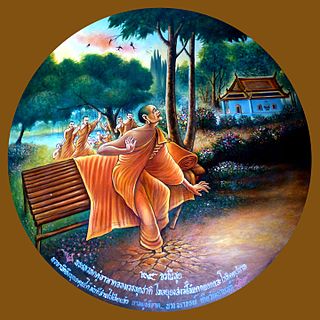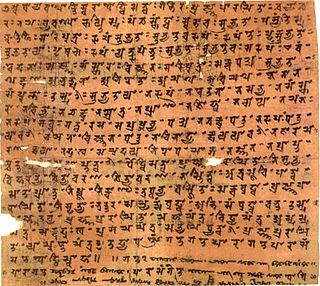Related Research Articles

Ashoka, also known as Asoka or Aśoka, and popularly known as Ashoka the Great, was Emperor of Magadha from c. 268 BCE until his death in 232 BCE, and the third ruler from the Mauryan dynasty. His empire covered a large part of the Indian subcontinent, stretching from present-day Afghanistan in the west to present-day Bangladesh in the east, with its capital at Pataliputra. A patron of Buddhism, he is credited with playing an important role in the spread of Buddhism across ancient Asia.

Siddhartha Gautama, most commonly referred to as the Buddha, was a wandering ascetic and religious teacher who lived in South Asia, during the 6th or 5th century BCE and founded Buddhism. According to Buddhist legends, he was born in Lumbini, in what is now Nepal, to royal parents of the Shakya clan, but renounced his home life to live as a wandering ascetic. After leading a life of mendicancy, asceticism, and meditation, he attained nirvana at Bodh Gaya in what is now India. The Buddha then wandered through the lower Indo-Gangetic Plain, teaching and building a monastic order. Buddhist tradition holds he died in Kushinagar and reached parinirvana.

The Jātaka are a voluminous body of literature native to the Indian subcontinent which mainly concern the previous births of Gautama Buddha in both human and animal form. Jataka stories were depicted on the railings and torans of the stupas. According to Peter Skilling, this genre is "one of the oldest classes of Buddhist literature." Some of these texts are also considered great works of literature in their own right.

Buddhist texts are religious texts that belong to, or are associated with, Buddhism and its traditions. There is no single textual collection for all of Buddhism. Instead, there are three main Buddhist Canons: the Pāli Canon of the Theravāda tradition, the Chinese Buddhist Canon used in East Asian Buddhist tradition, and the Tibetan Buddhist Canon used in Indo-Tibetan Buddhism.

Bindusara was the second Mauryan emperor of Magadha in Ancient India. The ancient Greco-Roman writers called him Amitrochates, a name likely derived from his Sanskrit title Amitraghāta.

The early Buddhist schools are those schools into which the Buddhist monastic saṅgha split early in the history of Buddhism. The divisions were originally due to differences in Vinaya and later also due to doctrinal differences and geographical separation of groups of monks. The original saṅgha split into the first early schools during or after the reign of Aśoka. Later, these first early sects were further divided into schools such as the Sarvāstivādins, the Dharmaguptakas, and the Vibhajyavādins, eventually proliferating into—according to traditional accounts—18 different schools.
Since the death of the historical Buddha, Siddhartha Gautama, Buddhist monastic communities ("sangha") have periodically convened to settle doctrinal and disciplinary disputes and to revise and correct the contents of the Buddhist canons. These gatherings are often termed Buddhist "councils". Accounts of these councils are recorded in Buddhist texts as having begun immediately following the death of the Buddha and have continued into the modern era. The earliest councils are regarded as real events by every Buddhist tradition. However, the historicity and details of these councils remains a matter of dispute in modern Buddhist studies. This is because various sources belonging to different Buddhist schools contain conflicting accounts of these events and the narratives often serve to bolster the authority and prestige of specific schools.

Devadatta was by tradition a Buddhist monk, cousin and brother-in-law of Gautama Siddhārtha. The accounts of his life vary greatly, but he is generally seen as an evil and divisive figure in Buddhism, who led a breakaway group in the earliest days of the religion.
Avadāna is the name given to a type of Buddhist literature correlating past lives' virtuous deeds to subsequent lives' events.

Upāli was a monk, one of the ten chief disciples of the Buddha and, according to early Buddhist texts, the person in charge of the reciting and reviewing of monastic discipline on the First Buddhist Council. Upāli belongs to the barber community. He met the Buddha when still a child, and later, when the Sakya princes received ordination, he did so as well. He was ordained before the princes, putting humility before caste. Having been ordained, Upāli learnt both Buddhist doctrine and vinaya. His preceptor was Kappitaka. Upāli became known for his mastery and strictness of vinaya and was consulted often about vinaya matters. A notable case he decided was that of the monk Ajjuka, who was accused of partisanship in a conflict about real estate. During the First Council, Upāli received the important role of reciting the vinaya, for which he is mostly known.

Pali literature is concerned mainly with Theravada Buddhism, of which Pali is the traditional language. The earliest and most important Pali literature constitutes the Pāli Canon, the authoritative scriptures of Theravada school.

Kātyāyana or Mahākātyāyana was a disciple of Gautama Buddha. He is listed as one of the ten principal disciples and was foremost in expanding on and explaining brief statements of the Buddha.

A Nagaraja is a king of the various races of the nāga, the divine or semi-divine, half-human, half-serpent beings that reside in the netherworld (Patala), and can occasionally take human form. Rituals devoted to these supernatural beings have been taking place throughout South Asia for at least two thousand years.
The Ashokavadana is an Indian Sanskrit-language text that describes the birth and reign of the third Mauryan Emperor Ashoka. It glorifies Ashoka as a Buddhist emperor whose only ambition was to spread Buddhism far and wide.
Mahākapphina (Pali) or Mahākapphiṇa (Sanskrit), also called Mahā Kapphina Thera, was an eminent Arhat from Uttarapatha and is considered foremost among those who taught the monks. Mahākapphina was his monastic name. He became disciple of the Buddha and is one of the five hundred Arhats who will be reborn and attain Buddhahood, according to Mahāyāna tradition. References to Kapphina can be found in the Jātakas, Buddhaghoṣa's Manorathapūranī, the Dhammapada Aṭṭhakathā, the Visuddhimagga, the Sāratthappakāsinī, the Saṃyutta Nikāya, the Aṅguttara Nikāya, the Vinaya Piṭaka, the Theragāthā, etc.; as well as in the Sanskrit Avadānaśatika.

The Pāli Canon is the standard collection of scriptures in the Theravada Buddhist tradition, as preserved in the Pāli language. It is the most complete extant early Buddhist canon. It derives mainly from the Tamrashatiya school.

Jīvaka was the personal physician of the Buddha and the Indian King Bimbisāra. He lived in Rājagṛha, present-day Rajgir, in the 5th century BCE. Sometimes described as the "Medicine King" and(pinyin: yi wang) and "Thrice Crowned physician" he figures prominently in legendary accounts in Asia as a model healer, and is honoured as such by traditional healers in several Asian countries.

Sanskrit Buddhist literature refers to Buddhist texts composed either in classical Sanskrit, in a register that has been called "Buddhist Hybrid Sanskrit", or a mixture of these two. Several non-Mahāyāna Nikāyas appear to have kept their canons in Sanskrit, the most prominent being the Sarvāstivāda school. Many Mahāyāna Sūtras and śāstras also survive in Buddhistic Sanskrit or in standard Sanskrit.

The Buddhist traditions have created and maintained a vast body of mythological literature. The central myth of Buddhism revolves around the purported events of the life of the Buddha. This is told in relatively realistic terms in the earliest texts, and was soon elaborated into a complex literary mythology. The chief motif of this story, and the most distinctive feature of Buddhist myth, is the Buddha's renunciation: leaving his home and family for a spiritual quest. Alongside this central myth, the traditions contain large numbers of smaller stories, which are usually supposed to convey an ethical or Buddhist teaching. These include the popular Jātakas, folk tales or legends believed to be past lives of Gautama Buddha. Since these are regarded as episodes in the life of the Buddha, they are treated here as “myth”, rather than distinguishing between myth, legend, and folk-tale.
Early Buddhist texts (EBTs), early Buddhist literature or early Buddhist discourses are parallel texts shared by the early Buddhist schools. The most widely studied EBT material are the first four Pali Nikayas, as well as the corresponding Chinese Āgamas. However, some scholars have also pointed out that some Vinaya material, like the Patimokkhas of the different Buddhist schools, as well as some material from the earliest Abhidharma texts could also be quite early.
References
- ↑ "Fables in the Vinaya-Pitaka of the Sarvastivadin School" by Jean Przyluski, in The Indian Historical Quarterly, Vol.V, No.1, 1929.03
- ↑ Winternitz, Moriz (1993). A History of Indian Literature: Buddhist literature and Jaina literature. Motilal Banarsidass Publishers. p. 273. ISBN 9788120802650.
- 1 2 3 Buswell, Jr., Robert; Lopez, Jr., Donald S. (2013). The Princeton Dictionary of Buddhism. Princeton University Press. p. 262. ISBN 9781400848058.
- ↑ Neil, Robert Alexander; Cowell, Edward B.: The Divyâvadâna: a collection of early Buddhist legends, now first edited from the Nepalese Sanskrit mss. in Cambridge and Paris; Cambridge: University Press 1886.
- ↑ Vaidya, P. L. (1959). Divyāvadāna Archived 2014-10-25 at the Wayback Machine , Darbhanga: The Mithila Institute of Post-Graduate Studies and Research in Sanskrit Learning (romanized)
- ↑ Kurt A. Behrendt, ed. (2007). The Art of Gandhara in the Metropolitan Museum of Art. Metropolitan Museum of Art. p. 44. ISBN 9781588392244.
- ↑ Bhikkhu Khantipalo (1995-2011). The Wheel of Birth and Death Access to Insight
- ↑ Dalai Lama (1992). The Meaning of Life, translated and edited by Jeffrey Hopkins. Wisdom, p. 45
- ↑ Digital Sanskrit Buddhist Canon, Language: Sanskrit, Script: Devanagari